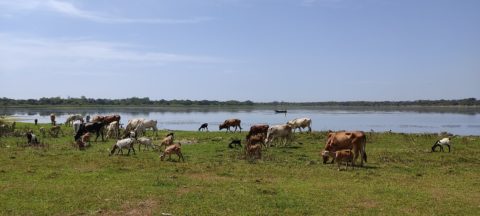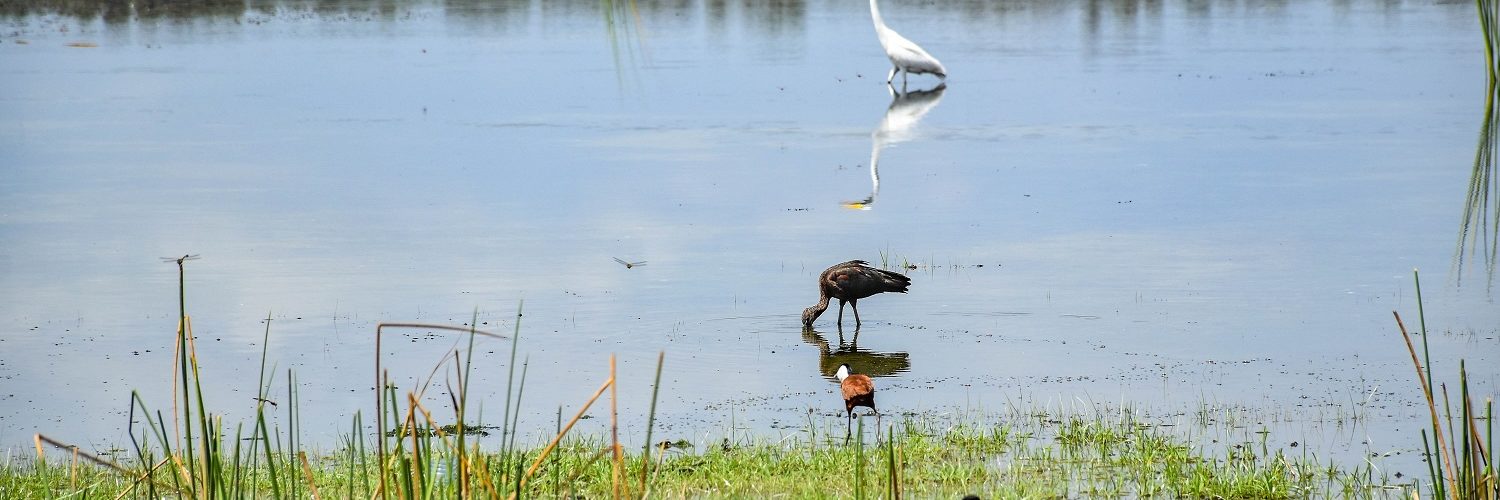For 40 years, David Muiga, aged 72, has lived in Mpeketoni, Lamu County, having transferred as a teacher from then Nandi District in the Rift Valley to settle at his new station. He became one of the thousands of immigrants in Mpeketoni, a settlement scheme set up by the national government in the 1970s for landless people drawn from other parts of Kenya.
With water readily available from Lake Kenyatta, and the industry of migrant communities, the area grew in leaps and bounds, mainly growing farm produce for sale in Lamu and other towns such as Malindi, Mombasa and as far afield as Garissa and Nairobi. Other than farming, locals engage in fishing and pastoralism. Some have shallow wells on their land, others boreholes, but Lake Kenyatta – a vital ground water recharge – has always been the soul of this settler community and the indigenous peoples, supporting over 80,000.
“When I moved here with my family, Lake Kenyatta was always full – even during the dry seasons. It was pristine; teeming with biodiversity. Livestock numbers were low as was human settlement. Lake Amu also existed, but would shrink during the dry seasons,” says Muiga.
Lake Kenyatta, also locally known as Lake Mukunganya, is Lamu’s biggest freshwater lake and one of the key fresh water bodies in Kenya’s coastal region. According to Water Resources Authority (WRA 2010), the entire Lake Kenyatta sub‐catchment stretches from Pangani to the North West, Koruna River to the East and extends to Indian Ocean to the South East. Its upper sub‐catchment area borders Garissa’s Ijara District to the north from which River Mukuru, its main inlet, originates. When Tana River occasionally floods, it drains some of these waters into the Lake.
In the earlier days, Muiga recalls, the lake was about 12 kilometres long and could sink 18-20 metres deep in the rainy season.
Besides being a source of water and an attraction for livelihoods, Lake Kenyatta is also biodiversity endowed area with birds, and aquatic and terrestrial species such as fish, hippo, reptiles, zebra, baboon, buffalo, warthog and water buck.
Shrinking lake
But as the population in Mpeketoni and the surrounding areas grew, the impact of uncontrolled human activity began to manifest. The lake started shrinking due to excessive water abstraction for irrigation. This was coupled with unsustainable fishing, encroachment and conversion of land in the buffer zone to agriculture, overgrazing and sand harvesting in the rivers that feed into the lake. Competition for the lake and its resources formed the genesis of recurring conflicts pitting farmers against pastoralists, and man against wildlife.

“Farming was done upstream along the riparian land of Mukuru River. This led to soil erosion. From 2007, pastoralists drove their cattle through the waterways between Mkunumbi and Witu, and the trampling loosened the soils, exacerbating erosion and resulting in sediment being dumped into the lake. Pangani was a marsh, today it no longer exists. Zebra area was also marshy but is now a human settlement. These days, hundreds of thousands of livestock are watered at Lake Kenyatta,” states Muiga.
Due to encroachment on wetlands within the basin, this once idyllic lake which has no surface outlet is also threatened by high siltation. Today, it’s the norm to find fishermen standing chest deep in the shallow waters.
This wasn’t always the case. There was no farming along Lake Kenyatta’s shores until 2000 when people encroached and began farming vegetables. Alarmed by this turn of events, the local government administration moved them away. Some sand dunes in Swabaha area close to Kiongwe were also encroached but this was halted by the National Environmental Management Authority (NEMA). Water would percolate through the sand, allowing fresh water to flow out and recharge the Lake. With settlement in the dunes compounded by numerous boreholes sunk in catchment zones, its ground water recharge dropped.
“People don’t understand that this is an ecosystem. Some bad practices in a sub-catchment will have an effect on the whole,” explains Muiga.
When he retired in 2006, Muiga together with like-minded community members formed the Lake Kenyatta WRUA to promote controlled and legal water use activities; good management practices for efficient and sustainable use of water resources; safeguard environmental flows for downstream use by nature and people, reduce water use conflicts and initiate catchment conservation measures to improve water quality and quantity. The WRUA has over 260 registered members and is at the forefront for the conservation and restoration of Lake Kenyatta and its catchment.
Starvation if Lake Disappears
Speaking during this year’s World Wetlands Day commemoration by the lake’s shores that had once been converted to a vegetable farm, Muiga supported plans by the Lamu County Government push for delineation among other solutions to save the water body.
“The gazettement of Lake Kenyatta Sub Catchment Conservation Area in 2021 was a significant step toward its protection, which is critical for the community because if this lake dries up, we will all starve,” he said.
Such fears are not far-fetched, given the ravages of climate change. As a result of a prolonged and severe drought between 2016 and 2017, the lake almost completely dried up, and with it, the livelihoods of hundreds of thousands who depend on it. Fishermen fled the area in search of other wetlands. Stench of death and despair filled the air as buffalo and hippo carcasses dotted the lake’s parched and cracking bed. Wild animals relocated to other areas but many ended up dying – starved of water and pasture or killed by farmers when they raided farms.
So dire was the situation that the local community took the unprecedented action of literally wetting the drying bed with water from an underground spring for almost three months to ensure it did not completely dry up. Today, the lake has shrunk to about seven kilometres long.
Way forward
The Lamu County Government is now collaborating with the National Management Environmental Authority (NEMA), Kenya Forest Service, Kenya Wildlife Service and other national government agencies to restore the lake through an initiative involving community-based organisations such as water resource users association, beach management units and non-governmental partners like Wetlands International as well.
“I have been to the lake numerous times but my recent visit was quite shocking to me. If we don’t do anything in the next five years, we will lose this precious wetland. My County has prioritised its restoration and there is a committee working earnestly together with the relevant national government agencies and other stakeholders.
“A County Spatial Plan and others are in the final phase and these will help us know which actions to take. But we need financial and technical support to undertake these as our budget allocation, which is the lowest in all Kenya’s counties, has other basic and competing needs such as health and education,” stated Issa Timamy, Governor of Lamu County.

Julie Mulonga with a pupil from Mpeketoni School planting a seedling at the lake’s buffer zone
Julie Mulonga, Wetlands International Eastern Africa Director, stresses on the need to conserve and restore coastal wetlands such as mangroves and revive threatened inland wetlands such as Lake Kenyatta as well. “To achieve Lake Kenyatta’s restoration, we need significant shifts in governance, policies and urgent interventions, and it is commendable that Lamu County Governor Issa Timamy is leading these efforts. Saving this lake is achievable if we all intensify our collaboration and actions locally, and also seek support from other interested stakeholders such as development partners and donors,” says Julie.
Muiga proposes a few quick wins and long-term solutions: growing trees and grass in the buffer zone and catchment areas, constructing earth pans for livestock and wildlife found between Mkunumbi and Witu, stopping encroachment in sub-catchment areas, fencing, and desilting the lake by technical experts to ensure its integrity is maintained.
“Scientists believe there is a possibility of Lake Kenyatta becoming extinct within 20 years if nothing is done now,” warns Julie.
Lead image: Lake Kenyatta abounds with birdlife, aquatic, reptilian and terrestrial species


Leave a comment